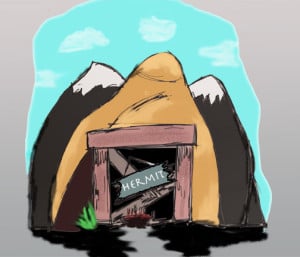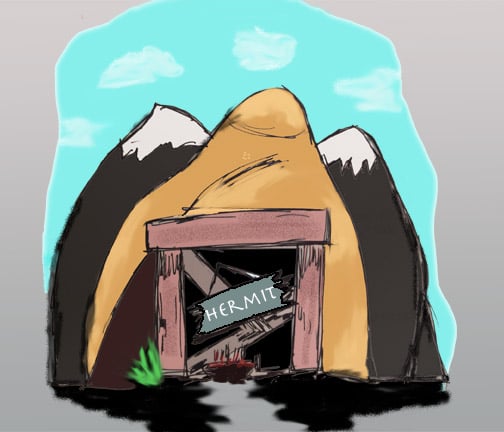Striding around under the fruit trees of his terraced garden, Domenico Grosso, the “hermit” of Jasper Ridge, was a familiar figure to the first few generations of Stanford students. He lived beside an abandoned mine shaft in a house he had built himself, surrounded by a chicken coop and stables, an outdoor picnic area for his many guests and an ornamental stream with carefully tended plants.
“It’s impossible to have a complete picture of life as it used to be in the Portola Valley neighborhood without knowing about one of its most intriguing and colorful early inhabitants,” said Nancy Lund, the Portola Valley town historian. “His life is the stuff of local legend.”
Grosso, who lived in the Stanford-owned Jasper Ridge Biological Preserve in Portola Valley, Calif., was the area’s unofficial guide. Especially after the University opened in 1891, Grosso enjoyed the company of many visitors. Hiking through maze of foot trails he maintained throughout the hills was a popular Sunday afternoon community pastime. Stanford students hiked the trails often, and even Jane Stanford is reported to have dropped in on occasion. Hospitable to the extreme, Grosso would sight visitors from afar and raise some combination of his American, Italian, French and Chilean flags.
He offered visitors homemade wine, a vinegary white for strangers and his best red for regulars. Also renowned as an excellent cook, he would invite people over to “come on and eat a rabbit leg” as he put it. His pickled miniature corn on the cob was a particular favorite.
But if complimented on his cooking, Grosso would brush it off by saying, “Julia did it.” Or when inviting friends over, he might say, “Don’t bring the Julia.” If someone played music, he would mutter something about Julia and ask that it stop. While no one knows who Julia was, it is believed she was an Italian sweetheart he left behind or who died shortly before he left Italy.
All this could only come from speculation, however, since Grosso was miserly with details of his prior life. In an interview in 1952, well after Grosso’s 1915 death, his friend Frank Bracesco revealed that he had served as a soldier under Giuseppe Garibaldi and had been a valet to the Duke of Genoa.
Grosso was most likely born near Genoa, Italy, in the 1830s. He came to America in 1869 and hinted that he had spent time in Panama and mining in Chile prior to reaching the continental United States. He first worked for Hippolyte Belloc’s banking company and later for Nicholas Larco as a ranch foreman. During this period, he is reputed to have discovered silver in what is now Jasper Ridge, but he claimed to have hidden the find by covering it with brush and burning it.

In 1875, when Larco became bankrupt, Belloc gave Grosso the prospecting rights to the land. He immediately moved there and set up his elaborate estate next to the 185-foot abandoned mine shaft in which he hoped to find silver. When the Stanfords purchased the property, they unsuccessfully tried to evict Grosso, but with his prospecting right, he could stay as long as he made attempts at mining.
For the rest of his life, Grosso would remain obsessed with the idea that someone was trying to take the mine from him. He went to great lengths to convince people he had found large quantities of high-grade silver, although records indicate that he never found anything worth more than one dollar per ton. Accounts differ, however, and some insist that he made a fortune.
“He kept mysterious bags under his house, which he claimed contained ore of the same quality as that in his display jars,” Lund said. “About once a year, he’d take the bags to Redwood City in a rented buggy, presumably to cash them in.”
It seems unlikely that the content of the bags proved lucrative, since in his later days, after Belloc’s widow stopped providing him a pension–the reasons behind her financial support of Grosso are ambiguous–he basically lived off the generosity of others, walking around with a sack in which he would accept vegetables and other necessities.
He could not work the mine on his own and was too suspicious of potential investors to ever open it up again. Instead, he dug over 20 surface pits in the hope of finding his elusive treasure.
In the spring of 1915, Gross suffered a stroke. He was discovered in his bed by Ida Bracesco a few days later. He died on May 18 in the San Mateo County Hospital, at 85 to 90 years of age.
In 1923, the Stanford Mining Department reopened the “Hermit Mine” to use as a practice mine. By this time, most traces of Grosso’s stay there had disappeared, even his house. But his story captured the interest of many students involved in the project. Who was this gentlemanly recluse who spoke five languages and kept up an impeccable appearance? Did the lonely and mysterious figure, with a beard down to his chest, ever actually make a “find?” What kept him up at night, sweeping his maze of paths in the moonlight?
The last official mention of the mine came in 1941, when the head of the mining department stated that it had not been touched in years. Today, thick hedges of poison oak guard the location of the mine, taking on Domenico Grosso’s legacy of protecting it from opportunistic hands.
In addition to an interview with Nancy Lund, this information was gathered from sources including “The history of Jasper Ridge: From Searsville pioneers to Stanford scientists” by Dorothy F. Regnery, Volume 27 of the Stanford Illustrated Review in the Stanford University Library Special Collections and University Archives, and “The hermit mine” by Merle Marion Repass.
-Amrita Rao
